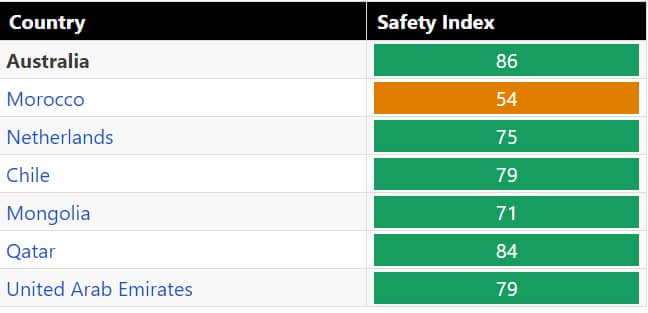
With this Australia travel guide, I aim to bring together in one place the main information you need to travel more and better.
It aims to prepare you to arrive at this new destination, knowing everything you need to have a smooth and safe trip.
It also aims to avoid the vast majority of problems that every traveler faces.
With this information, you will be able to make the best decisions, transforming your view of a place.
Here you will find the main places to visit, what the costs are, a great way to save money, recommendations for places to stay, restaurants, transport tips and safety advice.
Even with different ways of traveling, from backpacking, family vacations, cruises, two-week vacations, round the world trips.
Here you will find everything you need to travel more, better, for longer and cheaper.
If you cannot find any information, do not hesitate to contact me and I will be happy to answer.
About Australia
Climate
Australia is a huge country, which means that its climate varies significantly in different regions. Due to its size, we can find a wide range of climates, from tropical to desert and temperate climates. I will briefly highlight the main types of climates found in Australia:
Tropical Climate:
Northern Australia, including areas such as northern Queensland and the Northern Territory, experiences a tropical climate. These regions have two distinct seasons: the wet season, characterized by frequent and heavy rainfall during the summer months, and the dry season, with warm temperatures and drier weather during the winter.
Subtropical Climate:
Regions such as the east coast of Queensland and parts of New South Wales have a subtropical climate. Here, summers are hot and humid, while winters are milder.
Temperate Climate:
Most of southeastern Australia, including areas such as Sydney, Melbourne and Adelaide, has a temperate climate. Summers are hot, but not excessively hot, and winters can be cool, but rarely extremely cold.
Desert Climate:
Central Australia is dominated by deserts, such as the Simpson Desert and the Tanami Desert. In these areas, the weather is extremely dry and hot during the day, but the nights can be quite cold.
Mediterranean Climate:
Southwestern Australia, including Perth and some areas of South Australia, has a Mediterranean climate. This means hot, dry summers and mild, wet winters.
Subpolar Climate:
Some parts of Tasmania, especially at high altitudes, have a subpolar climate. This results in cold, snowy winters and cool summers.
Time Zones
Australia has several time zones due to its geographical size. The main time zones are as follows:
Australian Eastern Standard Time (AEST): UTC +10 hours. This covers states and territories such as Queensland, New South Wales, Victoria, Tasmania and the Australian Capital Territory.
Australian Central Standard Time (ACST): UTC +9:30 hours. This applies to areas such as the Northern Territory and parts of southern South Australia.
Australian Western Standard Time (AWST): UTC +8 hours. This applies to Western Australia.
In addition, Australia may also observe Daylight Saving Time (DST) in some regions, which can add an hour to the above time zones during the summer months, allowing for greater sunlight.
Not all areas of Australia observe Daylight Saving Time, and the start and end dates may vary depending on the state or territory.
Money
The currency used in Australia is the Australian dollar (code: AUD). The Australian dollar is the only currency in circulation in the country and is widely accepted in all regions, states and territories of Australia. It is represented by the symbol “$” or “A$” to differentiate it from other currencies that also use the symbol “$”.
The Australian dollar is subdivided into 100 cents, and there are notes of different values (such as $5, $10, $20, $50 and $100) and coins (such as 5 cents, 10 cents, 20 cents, 50 cents, $1 and $2).
When visiting Australia, it is recommended to exchange your currency for the local currency or use international credit/debit cards, which are widely accepted in shops, hotels and restaurants throughout the country.
Value restrictions
Australia currently requires anyone entering or leaving the country to declare any amount of cash (in foreign currency or Australian dollars) that is equal to or greater than AUD 10,000 or the equivalent in other currencies.
Where is it?
Australia is an island continent in the southern hemisphere, situated between the Indian Ocean and the Pacific Ocean.
It is located to the southeast of Asia and to the east of Papua New Guinea and Indonesia.
It is a vast and charming country, with several smaller islands around its coasts, including Tasmania and Christmas Island. With its vibrant cities such as Sydney, Melbourne, Brisbane and Perth, Australia charms with its relaxed and welcoming lifestyle, offering a multitude of cultural and natural experiences for those who visit.
A little history
Australia’s history is fascinating and rich, spanning thousands of years of cultural and social evolution. Before the arrival of Europeans, the Australian continent was already home to Aboriginal communities, who had a deep connection to the land and a rich set of traditions and beliefs.
European arrival on the territory began in 1606, with Dutch navigator Willem Janszoon exploring the Queensland region. However, it was not until 1770 that Captain James Cook, sailing under the British flag, formally claimed the east coast of the continent for Britain.
In the years that followed, Australia became a deportation point for criminals and prisoners from Britain, with the establishment of the penal colony of Sydney in 1788. This British presence gradually expanded across the continent, facing challenges and conflicts with existing Aboriginal communities.
Throughout the 19th century, Australia experienced rapid population growth, attracting immigrants from around the world in search of gold, farmland and economic opportunities. The Australian colonies developed and progressed, establishing local governments and seeking greater autonomy.
In 1901, the colonies united to form the Federation of Australia, becoming an independent nation with its own federal government. Australia maintained ties with Great Britain, becoming a Commonwealth nation.
During both World Wars, Australia supported Great Britain and its allies, and these conflicts had a major impact on the country, influencing its politics and culture. After World War II, Australia experienced a period of significant economic growth, with immigration playing an important role in shaping a multicultural and diverse society.
Since then, the country has been known for its rich biodiversity, stunning landscapes, popular sports such as cricket and rugby, and its active participation in global affairs.
Culture
Australia is a multicultural country with a rich cultural diversity due to its history of immigration and the coexistence of various ethnic communities. Australian culture is influenced by people of diverse origins, such as the Aboriginal and Torres Strait Islander peoples (the indigenous indigenous people), European settlers, Asians, Middle Easterners, Africans and many others.
Spoken language
English is the predominant and official language spoken in Australia. As a legacy of the British colonial period, English is the language used in everyday communication, government, business, education and in all spheres of Australian society.
It is important to note that, although English is the primary language, Australia is a culturally diverse nation.
The Aboriginal peoples of Australia also have their own indigenous languages, many of which are still spoken today. These languages have significant cultural value and are protected and preserved by Aboriginal communities.
However, for communication both domestically and internationally, English is the dominant language and therefore the main language you will encounter when visiting Australia.
Religion
Australia is a secular and religiously diverse nation. According to census data, the majority of the Australian population identifies as Christian, but there is a growing diversity of religious beliefs in the country.
The main religions practiced in Australia include:
Christianity is the largest religion in Australia, with several denominations present. The Roman Catholic Church is the largest Christian denomination, followed by the Anglican Church,
several Protestant churches such as the Uniting Church of Australia and Pentecostal denominations.
No Religion: A significant portion of the Australian population identifies as having no specific religion. These people may be agnostic, atheist or simply do not follow any particular religious faith.
In addition to Christianity and people of no religion, Australia is home to a variety of other religions due to immigration and cultural diversity. These include Islam, Buddhism, Hinduism, Sikhism and Judaism, among others.
Food
Australia’s cuisine is a delicious blend of culinary influences from many cultures around the world, reflecting the country’s diversity.
Australian food combines fresh flavours, high-quality ingredients and innovative dishes, often highlighting local and seasonal produce. Some notable features of Australian cuisine include:
Seafood: Due to the extensive coastline, seafood plays a prominent role in Australian cuisine. Dishes such as grilled prawns, crab, oysters and fresh fish are very popular, with Tasmanian lobsters being particularly prized.
Barbecue: Barbecuing is an essential part of Australian culture. Australians love to grill meats such as steak, sausages, lamb and chicken, often accompanied by fresh salads and tasty sauces.
Vegemite: An icon of Australian cuisine, Vegemite is a savory spread made from yeast extract, often eaten on buttered toast. Australians have a special relationship with this product, and it is an important part of many families’ breakfasts.
Due to the country’s cultural diversity, Australia offers a wide range of restaurants and establishments serving cuisines from all over the world. You can find a variety of Asian, Mediterranean, Indian, African and other dishes.
Main Courses
Australian Barbecue:
Barbecuing is an essential part of Australian culture.
Australians love to grill a variety of meats, including steak, sausages, lamb, chicken and seafood, often seasoned with flavorful marinades.

Meat Pie:
Meat Pies are a popular and iconic Australian quick meal. They are pies filled with meat cooked in gravy, typically served with tomato sauce or ketchup.

Fish and Chips:
This is a British heritage dish that is very popular in Australia. Fish and Chips is a classic dish consisting of fried fish, usually served with French fries and tartar sauce.

Vegemite on Toast:
Vegemite is a salty spread made from yeast extract, a product much loved by Australians.
The most common way to eat it is spread on buttered toast, a popular combination for breakfast or a quick snack.

Lamington:
Lamington is a famous Australian cake consisting of pieces of vanilla cake dipped in a chocolate coating and then in shredded coconut.

Pavlova:
Pavlova is a popular and controversial dessert, with Australia and New Zealand both disputing its origin. It is a crispy meringue pie, usually shaped like a nest, topped with whipped cream and fresh fruits such as strawberries, kiwi and passion fruit.

What to Do in Australia
Australia offers a wealth of exciting activities and memorable experiences for visitors. With its diverse range of stunning natural landscapes, unique wildlife, vibrant cities and rich culture, there is something for everyone. Here are some of the top things to do in Australia:
Explore the Cities:
Visit cities such as Sydney, Melbourne, Brisbane and Perth, and explore their iconic attractions such as the Sydney Opera House, Sydney Harbour Bridge, Eureka Tower, Brisbane’s South Bank and Kings Park in Perth.
Explore the Great Barrier Reef:
Snorkel or dive some of the most beautiful stretches of the UNESCO World Heritage-listed Great Barrier Reef to marvel at the colourful marine life and stunning coral.
Discover Wildlife:
Visit national parks such as Kakadu National Park in the north and Uluru-Kata Tjuta National Park in the centre of the country to spot Australian wildlife including kangaroos, koalas, emus and crocodiles.
Explore Tasmania:
Explore Tasmania, an island full of natural beauty, hiking trails, stunning scenery such as Cradle Mountain and a rich colonial history in Hobart.
Visit Fraser Island:
Venture to Fraser Island, the world’s largest sand island, with its sand dunes, rainforests and freshwater lakes.
Experience Aboriginal Culture:
Learn about the rich Aboriginal culture at cultural centres, join indigenous tourism tours and explore Aboriginal rock art sites.
Venture into the Outback:
Travel deep into the country’s Outback and discover arid landscapes, red rocks and iconic landmarks such as Uluru (Ayers Rock) and the Olgas (Kata Tjuta).
Enjoy the Beaches:
Relax on Australia’s beautiful beaches, such as Bondi Beach in Sydney, Surfers Paradise Beach on the Gold Coast and Whitehaven Beach in the Whitsunday Islands.
When to go to Australia
As Australia is a large and diverse country in terms of climate, it is important to consider the different regions and seasons before planning your trip.
Spring (September to November):
Spring is a great time to visit Australia, as many regions have pleasant weather and mild temperatures. It is ideal for exploring cities, visiting national parks and enjoying the beautiful flowers in bloom. The southern regions are starting to warm up, and the Great Barrier Reef is ideal for diving and snorkeling at this time.
Summer (December to February):
Summer is hot in most of Australia, especially in the north and inland. Coastal cities are popular during the summer, as the beaches are perfect for relaxing and enjoying water sports.
The south has a milder climate, making it a great time to explore cities and wine regions.
Autumn (March to May):
Autumn is another pleasant time to visit Australia, with mild temperatures and less chance of rain. It’s a great time to explore wine regions, hike in national parks and enjoy cultural festivals.
Winter (June to August):
Winter in Australia can be cold, especially in the southern regions and mountain areas. However, it’s a great time to visit the northern regions, such as the Great Barrier Reef and the tropical regions, where the weather is milder.
It’s also a popular time for snow activities in ski regions, such as the Snowy Mountains.
How to get there
There are no direct flights from Brazil to Sydney.
The shortest route is via Santiago (Chile) or Buenos Aires (Argentina).
For those with an American visa, there are many options via the United States.
See the beginning of my round-the-world trip.
As I wanted to buy some equipment, I went from São Paulo to Atlanta, Atlanta to Los Angeles and from Los Angeles to Sydney.
Check out some options on Skyscanner
Costs
3 styles and their costs
Backpacker:
Staying in hostels using shared dormitories, cooking your own meals and/or local and cheap restaurants, using local transportation, exploring the city on foot and taking free or cheaper tours.
Daily expenses: US$40.00 to US$60.00 per day
Intermediate:
Staying in hostels/budget hotels in private rooms, eating at average restaurants, going to the main paid attractions, using some taxis and Uber.
Daily expenses: US$100.00 to US$140.00 per day.
Check if Uber is available in the city you are visiting
Luxury:
Staying in the best hotels, going to all the attractions, hiring more sophisticated packages such as helicopter use, etc.
Daily expenses: US$220.00 and above per day
How to get around
Australia is a large country with a number of transport options available to get around the country, and the choice you make will depend on how much time you have and your budget.
Flying:
For covering long distances between cities, flying is the quickest and most convenient option. Australia has a well-developed aviation system, with several airlines offering domestic flights to many cities and regions.
Train:
Travelling by train is a scenic and relaxing option, especially when crossing spectacular landscapes, such as the iconic “The Ghan” route from Adelaide to Darwin or the “Indian Pacific” from Sydney to Perth.
I took the 24-hour journey between Brisbane and Cairns.
Bus:
Buses are an economical option for travelling between smaller cities and regions. There are several bus companies operating throughout Australia, offering popular routes and long-distance services.
Car:
Renting a car is a great option for exploring rural and more remote areas of Australia, offering flexibility and independence in your travels. The roads are well maintained and safe, making travelling by car an enjoyable experience.
Urban public transport:
In major cities such as Sydney, Melbourne, Brisbane, Adelaide and Perth, there are well-developed public transport systems, including trains, trams, buses and ferries. These options are convenient for getting around the cities.
How to Communicate
In Australia, there are several mobile phone operators that offer mobile phone services to consumers.
The cost depends on the days and amount of GB contracted, and prices range from US$8.00 to US$30.00.
The three main mobile phone operators in the country, which have wide coverage and are well-known, are:
Telstra: Telstra is the largest telecommunications operator in Australia and has the largest mobile network coverage in the country.
Optus: Optus is another major operator in Australia, offering a wide range of mobile phone, internet and television services.
Vodafone: Vodafone is a global telecommunications operator that also operates in Australia.
Security in Australia
Crime:
In general, Australia has seen a downward trend in crime rates in recent years. Violent crimes, such as murder and serious assault, tend to be less frequent compared to other countries.
Transportation:
Public transport in Australia is known for being generally efficient, safe and well-organised, offering a range of options to suit the needs of citizens and visitors.
In larger cities such as Sydney, Melbourne, Brisbane, Adelaide and Perth, you will even find subways and tram systems.
Risk of scams
Although Australia is not known for scams, in tourist destinations you should always be cautious when receiving change, negotiating rides or any type of service, and also never pay anything in advance.
I have not had any incidents on the transport used.

The index ranks countries from 0 to 100, with 0 to 33 being the most dangerous, 33 to 66 being somewhat safe/dangerous and 66 to 100 being the safest.
Documents and Vaccination
Visa:
Brazilians must obtain an Australian visa before traveling to Australia.
There are several types of visas available, depending on the purpose of the trip, such as tourism, study, work, among others.
It is important to apply for the correct visa and follow the instructions in the application process.
See information at the Australian Embassy in Brazil.
The “eTourist” program allows Brazilians to complete the entire visa application process online. The visa is valid for 1 year, but the maximum stay in the country for this visa is up to 3 months.
Valid passport:
Brazilians who wish to travel to Australia must have a valid passport with at least six months from the date of entry into the country.
Vaccinations:
To enter Australia, all travelers must be vaccinated against yellow fever at least ten days before their trip. The international vaccination card must remain with the passport upon arrival in the country.
